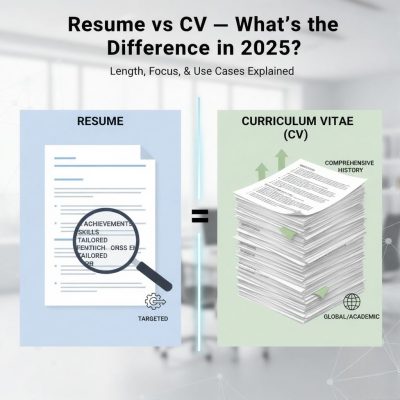If you’re applying for jobs in 2025, you’ve probably seen employers ask for a “resume” in one post and a “CV” in another.
But what’s the difference? Are they the same thing?
Although they’re often used interchangeably, a resume and a CV (Curriculum Vitae) are two different documents — each designed for specific purposes and regions.
Let’s break down the resume vs CV difference, when to use each, and how to create both easily with tools like the Opportunee Resume Builder.
What Is a Resume?
A resume is a short, targeted summary of your skills, work experience, and achievements — usually one page long.
It’s designed to show recruiters why you’re the best fit for a specific job.
✅ Key Features of a Resume:
- Length: 1 page (maximum 2 for experienced professionals)
- Focus: Skills, achievements, and recent work experience
- Purpose: Job applications (corporate, private sector)
- Customization: Tailored for each position
💡 Pro Tip: Always make your resume ATS-friendly. Check this How to Make Your Resume Pass Any ATS in 2025 (Free Online Checker Included)
What Is a CV (Curriculum Vitae)?
A CV is a comprehensive document that details your entire academic and professional history.
It’s typically used for academic, research, or international job applications.
✅ Key Features of a CV:
- Length: 2–5+ pages (no strict limit)
- Focus: Academic background, research, publications, and teaching experience
- Purpose: Academia, education, research, or international roles
- Customization: Usually static — updated only with new achievements
💡 Example:
If you’re applying for a university lecturer position, you’ll use a CV.
If you’re applying for a software engineering job at a startup, you’ll use a resume.
Resume vs CV: Quick Comparison Table (2025)
| Feature | Resume | CV (Curriculum Vitae) |
|---|---|---|
| Length | 1–2 pages | 2–5+ pages |
| Focus | Skills, experience, results | Full academic & career history |
| Use | Corporate, business, tech jobs | Academic, research, international roles |
| Customization | Tailored for each job | General and detailed |
| ATS Compatibility | Must be optimized for ATS | Usually not scanned by ATS |
| Format | Summary-based | Chronological and detailed |
When to Use a Resume vs CV
- Use a Resume for:
- Private companies
- Tech startups
- Job boards (LinkedIn, Indeed)
- U.S., Canada, Australia job markets
- Use a CV for:
- Academic or research positions
- Scholarships, fellowships
- International jobs (e.g., Europe, Africa)
Common Mistakes Applicants Make
❌ Submitting a 5-page CV for a private job application.
❌ Using a 1-page resume for a university postdoctoral role.
❌ Ignoring ATS formatting for resumes.
✅ Fix:
Use the Opportunee Resume Builder to automatically format the right version for your application type — Resume or CV — in minutes.
How to Create an ATS-Friendly Resume in 2025
- Use a simple, readable layout.
- Add job-specific keywords.
- Avoid tables, icons, and graphics.
- Save as .docx or text-based PDF.
You can test your final version using the Free ATS Scanner to ensure it passes automated filters.
Can You Use Both a Resume and CV?
Absolutely!
Many professionals maintain both versions — a short resume for job applications and a longer CV for academic or portfolio use.
Conclusion
In 2025, understanding the difference between a resume and CV can make or break your job application.
A resume gets you noticed fast; a CV tells your complete story.





